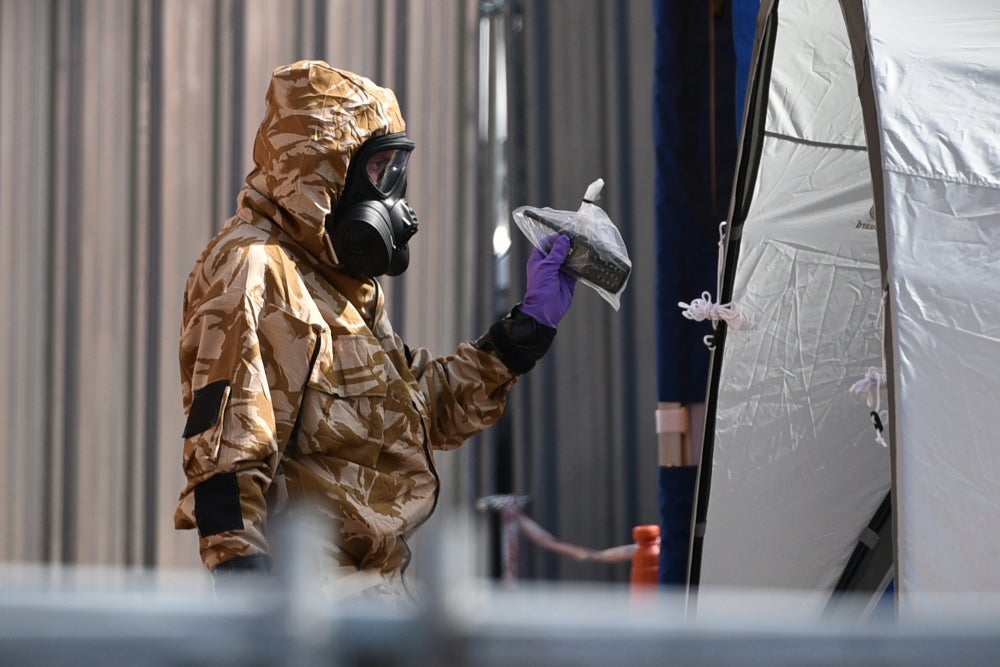
The atomic bomb is often thought of as the deadliest weapon, but there are a number of chemical, biological, radiological and nuclear (CBRN) weapons that can have an equally, or even more, devastating effect.
The H-bomb: a devastating force
The atomic bomb flattened Hiroshima and Nagasaki, killing more than 200,000 people. Yet it is not the deadliest weapon in the world’s military arsenals. The hydrogen bomb, or H-bomb, can be more than 1,000 times more powerful.
While atomic bombs use nuclear fission or atom-splitting (the same process as nuclear power plants), the thermonuclear H-bomb uses fusion. The same radioactive materials, uranium or plutonium, are used for fusion where atomic nuclei are brought together to create explosive energy.
Another factor for use in warfare is that H-bombs can be made small enough to fit on an intercontinental missile head. Experts point at this fact when they say North Korea had the US in mind when developing its H-bomb.
The United States, Russia, France, Britain and China already have H-bomb capability, and others may be working on it. After US H-bomb tests revealed how deadly they could be, the Treaty on the Non-Proliferation of Nuclear Weapons was introduced in 1970 and signed by 189 countries. Israel, India and Pakistan have not agreed to it, however, and North Korea withdrew from it in 2003.
The largest and most powerful thermo nuclear weapon of all time was the RDS-220 hydrogen bomb, also known as the Tsar Bomba. On 30 October 1961, the Soviet Union exploded the RDS-220 over Novaya Zemlya Island in the Russian Arctic Sea.
How well do you really know your competitors?
Access the most comprehensive Company Profiles on the market, powered by GlobalData. Save hours of research. Gain competitive edge.

Thank you!
Your download email will arrive shortly
Not ready to buy yet? Download a free sample
We are confident about the unique quality of our Company Profiles. However, we want you to make the most beneficial decision for your business, so we offer a free sample that you can download by submitting the below form
By GlobalDataIt had an explosive force of 50 megatons, equivalent to 50 million tonnes of TNT or 3,800 of the nuclear bomb that was dropped on Hiroshima.
Biological weaponry can wipe out whole populations
Biological weapons, or germ warfare, involve toxins or infectious agents used to incapacitate or kill. The potential for damage is huge, even bigger than the H-bomb. Properly engineered, pathogens could spread quickly into a target population, while aggressors could create vaccines to provide immunity to their own population.
During the Second World War, the Allies built facilities to mass produce anthrax, but the spores were never deployed. Symptoms from anthrax include itchy blisters and sores if caught through the skin, fever and swelling if digested. If inhaled, it will cause the victim to cough blood. If the victim then develops meningitis, there could be inflammation on the brain and spinal cord, which can be life-threatening.
Anthrax is infectious, but not contagious, so it could be used against a specified group of victims, unlike diseases such as plague or smallpox, which without vaccination, could spread beyond control and wipe out entire populations.
Biological weapons were banned by the UN in 1972 and have never been deployed in modern warfare. It has been reported that smallpox-infected blankets were distributed to native Americans by the British Army in the 18th century during the series of conflicts between UK and French colonists.
Chemical weapons cause serious psychological and physical effects
Chemical weapons incur far fewer deaths than a nuclear or H-bomb, but they can cause severe psychological and physical effects.
Novichok is believed to be one of the most toxic chemical weapons known and was developed in Soviet Russia.
Famous now for Russian assassination attempts in Salisbury, UK, in 2018, Novichok is eight times more toxic than the nerve agent VX developed for warfare.
VX affects the transmission of nerve impulses in the brain and has a similar composition to Novichok.
VX was developed in the UK in the early 1950s. It is persistent, so once released, it is slow to evaporate and can persist for days and even months in cold conditions. The vapour is heavier than air so it will sink to lie close to low-lying areas, making it an area-denial weapon. It is fast-acting and causes symptoms after seconds of exposure.
VX blocks an enzyme in the body, which causes molecules to constantly stimulate muscle and as they spasm they tire, causing death by asphyxiation or heart failure.
Another lethal nerve agent is Sarin, with a single drop able to kill a person very quickly, with effects similar to VX. It was developed in 1938 in Germany and reportedly used in 2013 across rebel-held suburbs in Damascus, Syria. Estimates of the death toll for the Syrian attack vary from 300 to 1,300, according to the BBC.
Chemical weapons were deployed by both sides during the First World War. Deaths from chlorine, mustard and phosgene gas during the conflict are believed to have totalled around 100,000.
Radioactive or ‘dirty bombs’ can cause widespread contamination
Another weapon of mass destruction in the CBRN group is the radioactive or ‘dirty bomb’. It is made by mixing radioactive material with standard explosives to cause it to spread.
Gamma rays from the radioactive source penetrate human skin and cause cellular damage.
A radioactive bomb cannot cause the levels of death and injury of the type and scale of nuclear and biological weapons, but it can leave incredibly expensive damage in costs of evacuation, relocation and clean-up. Buildings hit by a dirty bomb would have to be demolished and removed and access to affected areas would need to be limited because of contamination.
There is no known instance of a radioactive ‘dirty bomb’ being exploded.







